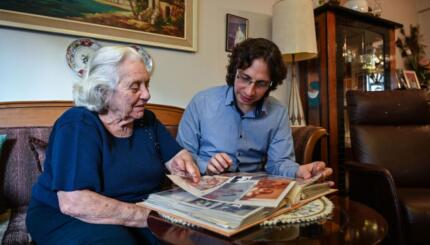Of all the different types of Jewish music, hazzanut [cantorial music] may be the most difficult to appreciate. In a sense, it is the Jewish equivalent of classical music. Just as classical music is an acquired taste, hazzanut needs to be worked at to be understood. By becoming more familiar with it, one can learn to enjoy it.
Hazzanut History
At one time, before the advent of recordings and easy access to popular entertainment, a performance by a hazzan [cantor] and his choir was the major form of entertainment for Jewish people. But somehow, the line between entertainment and davening [praying] became blurred. Hazzanim started singing many elaborate pieces in synagogue that were composed for the concert stage but were never really intended to be used during davening.
During the first half of the 20th century, hazzanut enjoyed what has become known as its golden age. While Yossele Rosenblatt was one of the first of Europe’s great hazzanim to move to America, he was not the only hazzan of his time to do so. Scores of highly talented hazzanim davened [prayed] in shuls in New York and other major cities. Recordings and concerts proliferated, and many of the most famous pieces of hazzanut were composed in that era.
Today, even those who tend to avoid shuls where the chazzan gives lengthy performances can often sing or hum some famous cantorial melodies, such as “Sheyibaneh Beit Hamikdash,” “Shehecheyanu,” and “Retzei.”
With your help, My Jewish Learning can provide endless opportunities for learning, connection and discovery.
Recordings
You might like, therefore, to learn to appreciate hazzanut outside of a shul setting, through recordings and concerts. There is a vast range of recordings by virtually all the great hazzanim of the past century that you may sample to discover your preferences.
Listen to the music a few times before you decide if you really like it. See how it reflects your own understanding of the words of the prayer. Or just enjoy it for the vocal artistry of the performer. Remember that–as in any art form–not every piece is of the same quality, and you have to learn how to be discriminating.
Here are five of the greatest hazzanim of the 20th century, who have left us extensive recordings:
• Yossele Rosenblatt (1882-1933) was one of the most prolific composers and recording artists of cantorial music. To hear his range–both vocal and emotional–listen to his “Hineni,” “Geshem” or “Ata Yatzarta.” His “Shir Hama’alot,” “Rachem Na,” “Vehu Rachum,” and “Kevakarat” are perhaps the most often-heard pieces that he made popular.
• Gershon Sirota (1874-1943) was one of the most powerful and highly trained tenors of his time, with climactic top notes and outstanding voice control. The only one of the great hazzanim of his era not to accept a position in America, Sirota perished in the Warsaw Ghetto. You can hear the emotional intensity of his dramatic tenor voice in the famous “Retzei” and in his rendition of “Unetaneh Tokef.” You can also hear his extraordinary vocal agility in “Veshamru.”
• Mordechai Hershman (1888-1940), one of a line of great hazzanim to serve at Temple Beth-El in Borough Park, Brooklyn, was a master of Yiddish folksong as well as hazzanut. The elegance and warmth of his singing and the power and sweetness of his tenor voice are evident in such pieces as “Eilu Devarim,” “Umipnei Chata’enu,” and “Tal.”
• Zavel Kwartin (1874-1953) is best known for his rendition of “Tiher Rabbi Yishma’el,” one of the most dramatic and moving pieces of hazzanut ever written. The intensity of Kwartin’s phrasing and delivery in such pieces as “Ve’al Yedei Avadecha” and “Uveyom Simhatkhem,” make him very worthwhile listening to.
• Moshe Koussevitzky (1899-1966) is still remembered by many as the greatest hazzan of the post-World War II era. He had a graceful and powerful lyric tenor with a phenomenal upper register with which he could do wonders. For sheer artistry, it is hard to beat his “Hashem Malach,” “Esa Einai,” or “Ledor Vador.” Koussevitzky’s rendition of Israel Schorr’s “Sheyibaneh Beit Hamikdash” is his most famous recording.
There are, of course, many more hazzanim to listen to. Some of them may be easier to appreciate, such as Shmuel Malavsky, Moishe Oysher, Leibele Waldman, or Richard Tucker. If you would like to hear a live performance by some of the leading hazzanim of our day, look for concerts by Chaim Adler, Yitzchak Meir Helfgot, Joseph Malovany, Benzion Miller, Yaacov Motzen, and Benjamin Muller, among others.
Since hazzanut is a genuinely Jewish art form, there is a special satisfaction involved in enjoying it. You may also discover that–through your enjoyment of the music–your familiarity with the words of the davening will be greatly enhanced. The rewards are many and varied, so buy your first tapes or CDs–in Judaica stores or on the Web–and learn to appreciate the unique manner in which generations of our people have chosen to speak to the Almighty–in words and in song.
This article looks at some of the great Orthodox cantors of yesterday and today. The non-Orthodox movements also have a rich heritage of great cantors, though they are omitted from this piece. Reprinted with permission from Jewish Action, the magazine of the Orthodox Union.
chazzan
Pronounced: khah-ZAHN, Origin: Hebrew, a cantor, one who sings liturgy in synagogue.
shul
Pronounced: shool (oo as in cool), Origin: Yiddish, synagogue.


